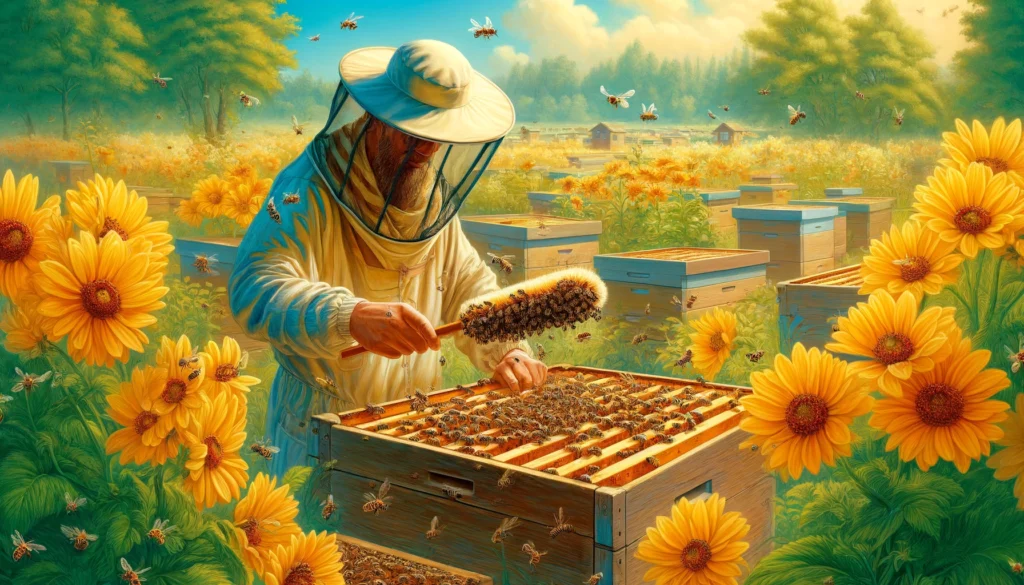
Bee Brush A detailed illustration showing a bee farmer using a Bee Brush on a hive in a vibrant natural setting. The farmer dressed in a protective beekeepin.webp.webp
Bee Brush
Definition
A bee brush is a specialized tool used in beekeeping to gently remove bees from frames, hive components, or other surfaces without harming them. Bee brushes typically consist of soft bristles attached to a handle and are designed to gently sweep bees away without crushing or injuring them. Bee brushes are an essential tool for beekeepers during hive inspections, honey harvesting, and other hive management activities.
Purpose
The primary purpose of a bee brush is to facilitate hive inspections and honey harvesting by allowing beekeepers to safely and effectively move bees out of the way. Bee brushes help beekeepers manipulate frames, hive components, and other surfaces without disturbing the bees or causing them unnecessary stress. By gently brushing bees aside, beekeepers can access hive contents more easily and minimize the risk of bee stings during hive inspections.
Fall off the barn roof and busted your keister? Life on the farm or ranch can be tough on the bum. Need a break? Laugh it off at FarmerCowboy.com, the #1 farm humor site. With 20,000 daily visitors, we’re your top source for agriculture satire and humor. Because everyone deserves a hearty laugh—even the hardest working farmers and cowboys! Join us and turn those long days into fun tales at FarmerCowboy.com.
Construction
Bee brushes are typically constructed with the following components:
- Bristles: Soft, flexible bristles made of natural or synthetic materials, such as horsehair, nylon, or soft animal hair. The bristles are arranged in a dense cluster to effectively sweep bees away while minimizing discomfort or injury.
- Handle: A sturdy handle made of wood, plastic, or metal, which provides a comfortable grip and allows the beekeeper to maneuver the brush with precision and control.
- Size and Shape: Bee brushes come in various sizes and shapes, with some featuring a flat, paddle-like design and others resembling traditional paintbrushes. The size and shape of the brush may vary depending on the beekeeper’s preferences and the specific application.
How to Use
Using a bee brush is simple and straightforward. Here’s how to use a bee brush effectively during hive inspections and honey harvesting:
- Approach Gently: Approach the bees or hive components you wish to brush with care and avoid sudden movements that may startle the bees.
- Gently Sweep: Hold the bee brush firmly but gently and use sweeping motions to brush the bees away from the area you wish to inspect or manipulate. Sweep the bees in the direction they are facing to encourage them to move away peacefully.
- Work Methodically: Work methodically and systematically, brushing bees away from each frame or hive component as you inspect or harvest honey. Take your time and be patient, allowing the bees to move out of the way at their own pace.
- Minimize Disturbance: Minimize disturbance to the bees as much as possible by avoiding excessive brushing or agitation. Be gentle and patient, and avoid brushing bees too forcefully, which may cause them to become agitated and defensive.
Maintenance
Proper maintenance of bee brushes is essential for ensuring their effectiveness and longevity. After each use, clean the brush thoroughly to remove any honey, wax, or debris that may have accumulated on the bristles. Allow the brush to air dry completely before storing it in a clean, dry location away from direct sunlight and moisture.
Conclusion
Bee brushes are indispensable tools for beekeepers, allowing them to safely and effectively manipulate bees and hive components during hive inspections and honey harvesting. By understanding how to use bee brushes properly and practicing gentle handling techniques, beekeepers can minimize stress to the bees and promote a harmonious relationship between beekeepers and their hives. With proper maintenance and care, bee brushes will continue to serve beekeepers well for many seasons of beekeeping.
Originally posted 2005-12-19 23:03:40.
Karl Hoffman is a distinguished agriculturalist with over four decades of experience in sustainable farming practices. He holds a Ph.D. in Agronomy from Cornell University and has made significant contributions as a professor at Iowa State University. Hoffman’s groundbreaking research on integrated pest management and soil health has revolutionized modern agriculture. As a respected farm journalist, his column “Field Notes with Karl Hoffman” and his blog “The Modern Farmer” provide insightful, practical advice to a global audience. Hoffman’s work with the USDA and the United Nations FAO has enhanced food security worldwide. His awards include the USDA’s Distinguished Service Award and the World Food Prize, reflecting his profound impact on agriculture and sustainability.





